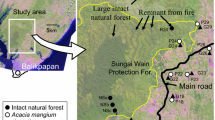Abstract
Urban reserves provide a major opportunity for conservation of indigenous biodiversity in the heavily urbanised landscape of Waitakere City (Auckland), New Zealand. However, there is little documented information on what indigenous fauna survives in these reserves. Beetle (Coleoptera) communities associated with two small, isolated urban reserves and two sites in a larger forest area within the Waitakere Ranges were sampled using pitfall traps and analysed. A total of 887 beetles, from 23 families and 89 recognisable taxonomic units were caught. The urban reserves had a marked reduction in species richness and abundance of beetles compared with the sites within the larger forest areas. Various environmental factors influencing the distribution of beetles across the sites were investigated. The most important factors were size of fragment, local forest cover and soil moisture. ‘Common’ species (>5 specimens in the total dataset) found in the Waitakere Ranges and small urban reserves, were either endemic or indigenous to New Zealand. Therefore, even though these reserves may be isolated from a larger, more continuous forest tract, they have considerable potential as reservoirs of beetle diversity in highly modified landscapes and the contribution of urban reserves to the local sustainability of beetle assemblages emphasises the importance of maintaining ‘green’ areas in and around cities.
Similar content being viewed by others
References
Alaruikka D., Kotze D.J., Mateveinen K. and Niemela J. 2002. Carabid beetle and spider assemblages along a forested urban-rural gradient in Southern Finland. J. Insect Conserv. 6: 195-206.
Allan H.H. 1961. Flora of New Zealand Volume I. R.E. Owen, Government Printer, Wellington, NZ.
Belbin L. 1995. PATN: Pattern Analysis Package. Technical reference. CSIRO Division of Wildlife and Ecology, Canberra.
Bolger D.T., Suarez A.V., Crooks K.R., Morrison S.A. and Case T.J. 2000. Arthropods in urban habitat fragmentation in Southern California: area, age, and edge effects. Ecol. Appl. 10: 1230-1248.
Brown K.S. and Freitas A.V.L. 2002. Butterfly communities of urban forest fragments in Campinas, São Paulo, Brazil: structure, instability, environmental correlates, and conservation. J. Insect Conserv. 6: 217-231.
Burke D. and Goulet H. 1998. Landscape and area effects on beetle assemblages in Ontario. Ecography 21: 472-479.
Butterfield J. 1997. Carabid community succession during the forestry cycle in conifer plantations. Ecography 20: 614-626.
Connor H.E. and Edgar E. 1987. Name changes in the indigenous New Zealand Flora, 1960-1986, and Nomina Nova IV, 1983-1986. New Zeal. J. Bot. 25: 115-170.
Crisp P.N., Dickinson K.J.M. and Gibbs G.W. 1998. Does native invertebrate diversity reflect native plant diversity? A case study from New Zealand and implications for conservation. Biol. Conserv. 83: 209-220.
Didham R.K. 1997. The influence of edge effects and forest fragmentation on leaf litter invertebrates in central Amazonia. In: Laurance W.F. and Bierregaard R.O. Jr. (eds), Tropical Forest Remnants: Ecology, Management and Conservation of Fragmented Communities, University of Chicago Press, Chicago.
Didham R.K. 1998. Altered leaf-litter decomposition rates in tropical forest fragments. Oecologia 116: 397-406.
Didham R.K., Hammond P.M., Lawton J.H., Eggleton P. and Stork N.E. 1998. Beetle species responses to tropical forest fragmentation. Ecol. Monogr. 68: 295-323.
Faith D.P., Minchin P.R. and Belbin L. 1987. Compositional dissimilarity as a robust measure of ecological distance. Vegetatio 69: 57-68.
Gardner S.M., Hartley S.E., Davies A. and Palmer S.C.F. 1997. Carabid communities on heather moorlands in Northeast Scotland: the consequences of grazing pressure for community diversity. Biol. Conserv. 81: 275-286.
Gibb H. and Hochuli D.F. 2002. Habitat fragmentation in an urban environment: large and small fragments support different arthropod assemblages. Biol. Conserv. 106: 91-100.
Gibbs J.P. and Stanton E.J. 2001. Habitat fragmentation and arthropod community change: Carrion beetles, phoretic mites, and flies. Ecol. Appl. 11: 79-85.
Harrison S. and Bruna E. 1999. Habitat fragmentation and large-scale conservation: what do we know for sure? Ecography 22: 225-232.
Holmes P.R., Boyce D.C. and Reed D.K. 1993. The ground beetle Coleoptera: Carabidae fauna of Welsh peatland biotopes: factors influencing the distribution of ground beetles and conservation implications. Biol. Conserv. 63: 153-161.
Hutcheson J.A. 1997. Community entomology-presidential address. New Zeal. Entomol. 20: 1-7.
Klein B.C. 1989. Effects of forest fragmentation on dung and carrion beetle communities in central Amazonia. Ecology 70: 1715-1725.
Kuschel G. 1990. Beetles in a suburban environment: a New Zealand case study. Department of Scientific and Industrial Research, Wellington, NZ.
Lovei G.L. and Cartellieri M. 2000. Ground beetles (Coleoptera, Carabidae) in forest fragments of the Manawatu, New Zealand: collapsed assemblages? J. Insect Conserv. 4: 239-244.
Luff M.L., Eyre M.D. and Rushton S.P. 1992. Classification and prediction of grassland habitats using ground beetles Coleoptera: Carabidae. J. Environ. Manage. 35: 301-315.
Magurran A.E. 1988. Ecological Diversity and its Measurement. Princeton University Press, Princeton, New Jersey.
McColl H.P. 1974. The arthropods of the floors of six forest types on the West Coast, South Island: a preliminary report. Proc. New Zeal. Ecol. Soc. 21: 11-16.
McCraken D.I. 1994. A fuzzy classification of moorland ground beetle Coleoptera: Carabidae and plant communities. Pedobiologia 38: 12-27.
McGeoch M.A. and Chown S.L. 1997. Impact of urbanization on a gall-inhabiting Lepidoptera assemblage: the importance of reserves in urban areas. Biodivers. Conserv. 6: 979-993.
McGeoch M.A. and Gaston K.J. 2000. Edge effects on the prevalence and mortality factors of Phytomyza ilicis (Diptera, Agromyzidae) in a suburban woodland. Ecol. Letts. 3: 23-29.
Minchin P.R. 1987. An evaluation of the robustness of techniques for ecological ordination. Vegetatio 69: 89-107.
Moeed A. and Meads M.J. 1985. Seasonality of pitfall trapped invertebrates in three types of native forest, Orongorongo Valley, New Zealand. New Zeal. J. Zool. 12: 17-53.
Moore L.B. and Edgar E. 1970. Flora of New Zealand. Volume II. Government Printer, Wellington, NZ.
Poole A.L. and Adams N.M. 1994. Trees and Shrubs of New Zealand. Manaaki Whenua Press, Canterbury, 256 pp.
Quinn M.A., Kepner R.L., Walgenbach D.D., Nelson Foster R., Bohls R.A., Pooler P.D., Reuter K.C. and Swain J.L. 1991. Effect of habitat characteristics and perturbation from insecticides on the community dynamics of ground beetles (Coleoptera: Carabidae) on mixed-grass rangeland. Environ. Entomol. 20: 1285-1294.
Reay S.D. and Norton D.A. 1999. Assessing the success of restoration plantings in a temperate New Zealand forest. Restor. Ecol. 7: 298-308.
Ricketts T.H., Daily G.C., Ehrlich P.R. and Fay J.P. 2001. Countryside biogeography of moths in a fragmented landscape: biodiversity in a native and agriculture habitats. Conserv. Biol. 15: 378-388.
Sanderson R.A., Ruston S., Cherrill A.J. and Byrne J.P. 1995. Soil, vegetation and space: an analysis of their effects on the invertebrate communities of a moorland in north-east England. J. Appl. Ecol. 32: 506-518.
Southwood T.R.E. 1978. Ecological Methods. Chapman and Hall, London, UK.
Steffan-Dwenter I. and Tscharntke T. 2000. Butterfly community structure in fragmented habitats. Ecol. Letts. 3: 449-456.
Suarez A.V., Bolger D.T. and Case T.J. 1998. Effects of fragmentation and invasion on native ant communities in coastal southern California. Ecology 79: 2041-2056.
Tscharntke T., Steffan-Dwenter I., Kruess A. and Thies C. 2002. Contribution of small habitat fragments to conservation of insect communities of grassland-cropland landscapes. Ecol. Appl. 12: 354-363.
Uetz G.W. 1979. The influence of variation in litter habitats on spider communities. Oecologia 40: 29-42.
Watts C.H. and Gibbs G.W. 2000. Species richness of indigenous beetles in restored plant communities on Matiu-Somes Island, Wellington Harbour, New Zealand. New Zeal. J. Ecol. 24: 195-200.
Watts C.H. and Gibbs G.W. 2002. Revegetation and its effect on the ground-dwelling beetle fauna of Matiu-Somes Island, New Zealand. Restor. Ecol. 10: 96-106.
Webb N.R., Clarke R.T. and Nicholas J.T. 1984. Invertebrate diversity on fragmented Calluna-heathland: effects of surrounding vegetation. J. Biogeogr. 11: 41-46.
Webb C.J., Sykes W.R. and Garnock-Jones P.J. 1988. Flora of New Zealand Volume IV. Department of Scientific and Industrial Research, Christchurch, NZ.
Author information
Authors and Affiliations
Corresponding author
Rights and permissions
About this article
Cite this article
Watts, C.H., Larivière, MC. The importance of urban reserves for conserving beetle communities: a case study from New Zealand. Journal of Insect Conservation 8, 47–58 (2004). https://doi.org/10.1023/B:JICO.0000027504.92727.ab
Issue Date:
DOI: https://doi.org/10.1023/B:JICO.0000027504.92727.ab




